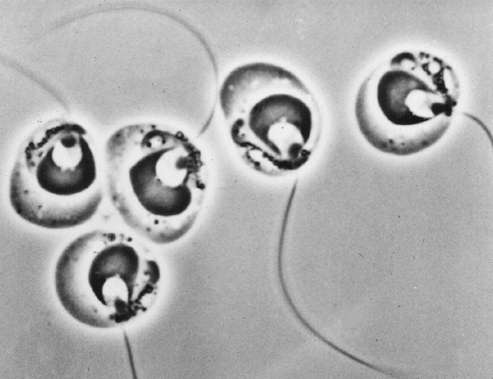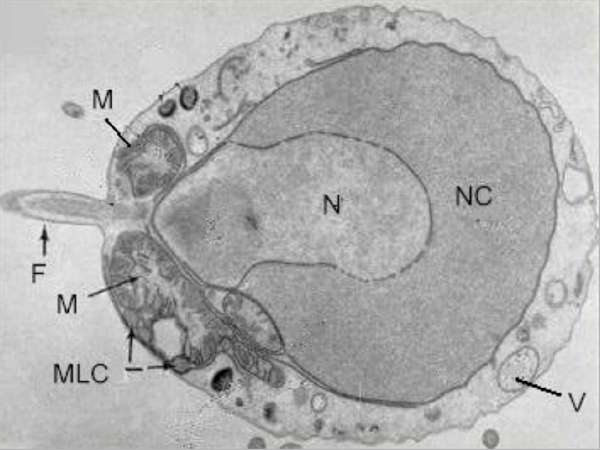MORE IMAGES FROM CHAPTER
10:
Fig 10.12a Zoospores of Blastocladiella emersonii (Chytridiomycota) each with a smooth, posterior whiplash flagellum (n = nucleus; nc = nuclear cap; m = mitochondrion; flag = flagellum) [Courtesy of M. S. Fuller].
Fig 10.12b: Electron micrograph of a longitudinal section of the zoospore of B. emersonii. The zoospore plasma membrane is continuous with the flagellar membrane (F) but only part of the flagellum is seen in this section. V = vacuole; mlc = microbody-lipid globule complex. [Courtesy of M. S. Fuller; from Reichle & Fuller, 1987]
Fig 10.13 Top: scanning electron micrograph of a zoospore of Phytophthora (Oomycota) with a posterior whiplash flagellum and a shorter, anterior tinsel-type flagellum. [Image courtesy of M. S. Fuller] Bottom: diagrammatic representation of the zoospore, showing the insertion of the flagella in the ventral groove (shaded) and the location of the nucleus (N) and water-expulsion vacuole (W)
Fig 10.15 Close-up of a part of the zoospore surface of Pythium aphanidermatum, showing the laminate peripheral cisternae that will subsequently become vesicles for release of the cyst wall.
Fig 10.17 Top left: Oat root tips with natural blue autofluorescence caused by the presence of avenacin. Top right: a Pythium zoospore undergoing disorganisation and lysis in the presence of avenacin. Lower sequence: Responses of wall-less zoospores of Oomycota to saponins such as avenacin or ß-aescin. (a) motile zoospore; (b) immobilisation and rounding-up; (c) development of phase-dark granules, (d) localisation of granules and development of vacuoles; (e) lysis; (f,g) ballooning followed by lysis. Disruption of the zoospores usually occurs within 5-10 minutes. [From Deacon & Mitchell, 1985]
Fig 10.18 Zoospore tracks of Oomycota, captured as negatives on photographic film during a 5-second exposure and showing frequent random turns in the absence of an attractant.
Fig 10.19 The homing and docking sequence of zoospores. See Chapter 10 for details.
Fig 10.20 Accumulation and encystment of Pythium zoospores on wheat roots. Left: zoospores (z) accumulating in large numbers on the surface of a ball of root tip mucilage; some root cap cells are indicated (rc). Right: zoospores (z) accumulating and encysting in the elongation zone of wheat roots. In this case the root had been coated with a double layer of calcium alginate gel to block any specific receptor compounds on the root surface.
Fig 10.21a A suspension of zoospores of Phytophthora parasitica was incubated in the presence of a fluorescent probe (fura-2) that measures Ca2+ concentration in the suspending fluid. The zoospore suspension was then vortexed (70 second interruption) to induce zoospore encystment and the external Ca2+ measurements were resumed. The trace shows that zoospore encystment caused an immediate drop in external Ca2+ (signifying Ca2+ uptake by zoospores), then a progressive Ca2+ release from the cysts, which germinated within 90 min.
Fig. 10.21b,c. In identical experiments, the addition of lanthanum or verapamil (both of which are Ca2+ channel blockers) prevented the release or uptake of Ca2+. The vortexed cells were immobilised but did not produce cyst walls. Another calcium-modulator, TMB-8, caused the cells initially to behave like the controls (an early uptake of Ca2+ after vortex-treatment) but with no subsequent release of Ca2+ and no germination. TMB-8 is known to block the release of Ca2+ from intracellular stores. [All data from Warburton & Deacon, 1998] |
|||||||||||||









